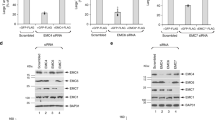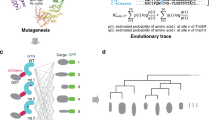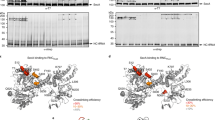Abstract
A viral inner nuclear membrane–sorting motif sequence (INM-SM) was used to identify proteins that recognize integral membrane proteins destined for the INM. Herein we describe importin-α-16, a membrane-associated isoform of Spodoptera frugiperda importin-α that contains the C-terminal amino acid residues comprising armadillo helical-repeat domains 7–10. In the endoplasmic reticulum (ER) membrane, importin-α-16 is adjacent to the translocon protein Sec61α. Importin-α-16 cross-links to the INM-SM sequence as it emerges from the ribosomal tunnel and remains adjacent to the INM-SM after INM-SM integration into the ER membrane and release from the translocon. Cross-linking results suggest that importin-α-16 discriminates between INM- and non–INM-directed proteins. Thus, it seems that during and after cotranslational membrane integration, importin-α-16 is involved in the trafficking of integral membrane proteins to the INM.
This is a preview of subscription content, access via your institution
Access options
Subscribe to this journal
Receive 12 print issues and online access
$189.00 per year
only $15.75 per issue
Buy this article
- Purchase on Springer Link
- Instant access to full article PDF
Prices may be subject to local taxes which are calculated during checkout







Similar content being viewed by others
References
Hetzer, M., Walther, T.C. & Mattaj, I.W. Pushing the envelope: structure, function and dynamics of the nuclear periphery. Annu. Rev. Cell Dev. Biol. 21, 347–380 (2005).
Saksena, S., Shao, Y., Braunagel, S.C., Summers, M.D. & Johnson, A.E. Cotranslational integration and initial sorting at the endoplasmic reticulum translocon of protein destined for the inner nuclear membrane. Proc. Natl Acad. Sci. USA 101, 12537–12542 (2004).
Braunagel, S.C. et al. Trafficking of ODV-E66 is mediated via a sorting motif and other viral proteins: facilitated trafficking to the inner nuclear membrane. Proc. Natl Acad. Sci. USA 101, 8372–8377 (2004).
Ohba, T., Schirmer, E.C., Nishimoto, T. & Gerace, L. Energy- and temperature-dependent transport of integral proteins to the inner nuclear membrane via the nuclear pore. J. Cell Biol. 167, 1051–1062 (2004).
Hong, T., Summers, M.D. & Braunagel, S.C. N-terminal sequences from Autographa californica nuclear polyhedrosis virus envelope proteins ODV-E66 and ODV-E25 are sufficient to direct reporter proteins to the nuclear envelope, intranuclear microvesicles and the envelope of the occlusion-derived virus. Proc. Natl Acad. Sci. USA 94, 4050–4055 (1997).
Rosas-Acosta, G., Braunagel, S.C. & Summers, M.D. Effects of deletion and overexpression of the Autographa californica nuclear polyhedrosis virus FP25K gene on synthesis of two occlusion-derived virus envelope proteins and their transport into virus-induced intranuclear membranes. J. Virol. 75, 10829–10842 (2001).
Crowley, K.S., Liao, S., Worrell, V.E., Reinhart, G.D. & Johnson, A.E. Secretory proteins move through the endoplasmic reticulum membrane via an aqueous, gated pore. Cell 78, 461–471 (1994).
Crowley, K.S., Reinhart, G.D. & Johnson, A.E. The signal sequence moves through a ribosomal tunnel into a noncytoplasmic aqueous environment at the ER membrane early in translocation. Cell 73, 1101–1115 (1993).
Lee, J.M. et al. Molecular cloning and characterization of the translationally controlled tumor protein gene in Bombyx mori. Comp. Biochem. Physiol. B Biochem. Mol. Biol. 139, 35–43 (2004).
Altschul, S.F. et al. Gapped BLAST and PSI-BLAST: a new generation of protein database search programs. Nucleic Acids Res. 25, 3389–3402 (1997).
Goldfarb, D.S., Corbett, A.H., Mason, D.A., Harreman, M.T. & Adam, S.A. Importin α: a multipurpose nuclear-transport receptor. Trends Cell Biol. 14, 505–514 (2004).
Miyamoto, Y. et al. Importin α can migrate into the nucleus in an importin β- and Ran-independent manner. EMBO J. 21, 5833–5842 (2002).
McCormick, P.J., Miao, Y., Shao, Y., Lin, J. & Johnson, A.E. Cotranslational protein integration into the ER membrane is mediated by the binding of nascent chains to translocon proteins. Mol. Cell 12, 329–341 (2003).
Jakel, S., Mingot, J.-M., Schwarzmaier, P., Hartmann, E. & Görlich, D. Importins fulfill a dual function as nuclear import receptors and cytoplasmic chaperones for exposed basic domains. EMBO J. 21, 377–386 (2002).
Chook, Y.M. & Blobel, G. Karyopherins and nuclear import. Curr. Opin. Struct. Biol. 11, 703–715 (2001).
Harel, A. & Forbes, D.J. Importin beta: conducting a much larger cellular symphony. Mol. Cell 16, 319–330 (2004).
Kotera, I. et al. Importin α transports CaMKIV to the nucleus without utilizing importin β. EMBO J. 24, 942–951 (2005).
Kamata, M., Nitahara-Kasahara, Y., Miyamoto, Y., Yoneda, Y. & Aida, Y. Importin-α promotes passage through the nuclear pore complex of human immunodeficiency virus Type 1 Vpr. J. Virol. 79, 3557–3564 (2005).
Pemberton, L.F., Rosenblum, J.S. & Blobel, G. Nuclear import of the TATA-binding protein: mediation by the karyopherin Kap114p and a possible mechanism for intranuclear targeting. J. Cell Biol. 145, 1407–1417 (1999).
Belanger, K.D., Kenna, M.A., Wei, S. & Davis, L.I. Genetic and physical interactions between Srp1p and nuclear pore complex proteins Nup1p and Nup2p. J. Cell Biol. 126, 619–630 (1994).
Solsbacher, J., Maurer, P., Vogel, F. & Schlenstedt, G. Nup2p, a yeast nucleoporin, functions in bidirectional transport of importin α. Mol. Cell. Biol. 20, 8468–8479 (2000).
Moroianu, J., Blobel, G. & Radu, A. RanGTP-mediated nuclear export of karyopherin α involves its interaction with the nucleoporin Nup153. Proc. Natl Acad. Sci. USA 94, 9699–9704 (1997).
Lindsay, M.E., Plafker, K., Smith, A.E., Clurman, B.E. & Macara, I.G. Npap60/Nup50 is a tri-stable switch that stimulates importin-α:β-mediated nuclear protein import. Cell 110, 349–360 (2002).
Moore, M.S. Npap60: a new player in nuclear protein import. Trends Cell Biol. 13, 61–64 (2003).
Matsuura, Y. & Stewart, M. Nup50/Npap60 function in nuclear import complex disassembly and importin recycling. EMBO J. 24, 3681–3689 (2005).
Hanz, S. & Fainzilber, M. Integration of retrograde axonal and nuclear transport mechanisms in neurons: implications for therapeutics. Neuroscientist 10, 404–408 (2004).
Hanz, S. et al. Axoplasmic importins enable retrograde inujry signaling in lesioned nerve. Neuron 40, 1095–1104 (2003).
Blesch, A. & Tuszynski, M.H. Nucleus hears axon's pain. Nat. Med. 10, 236–237 (2004).
Hachet, V., Köcher, T., Wilm, T. & Mattaj, I.W. Importin α associates with membranes and participates in nuclear envelope assembly in vitro. EMBO J. 23, 1526–1535 (2004).
Marzalek, J.R. et al. Genetic evidence for selective transport of opsin and arrestin by kinesin-II in mammalian receptors. Cell 102, 175–187 (2000).
Williams, D.S. Transport to the photoreceptor outer segment by myosin VIIa and kinesin II. Vision Res. 42, 455–462 (2002).
Schatz, C.A. et al. Importin α-regulated nucleation of microtubules by TPX2. EMBO J. 22, 2060–2070 (2003).
Gruss, O.J. et al. Ran induces spindle assembly by reversing the inhibitory effect of importin α on TPX2 activity. Cell 104, 83–93 (2001).
Beniya, H., Braunagel, S.C. & Summers, M.D. Autographa californica nuclear polyhedrosis virus: subcellular localization and protein trafficking of BV/ODV-E26 to intranuclear membranes and viral envelopes. Virology 240, 64–75 (1998).
Worman, H.J. & Courvalin, J.-C. Nuclear envelope, nuclear lamina, and inherited disease. Int. Rev. Cytol. 246, 231–279 (2005).
Braunagel, S.C., Elton, D.M., Ma, H. & Summers, M.D. Identification and analysis of an Autographa californica nuclear polyhedrosis virus structural protein of the occlusion-derived virus envelope, ODV-E56. Virology 217, 97–110 (1996).
Sambrook, J., Fritsch, E.F. & Maniatis, T. Molecular Cloning: A Laboratory Manual (Cold Spring Harbor Laboratory Press, Cold Spring Harbor, New York, USA, 1989).
Acknowledgements
We thank C. Gross, Vertex Pharmaceuticals, for the Sf9 cDNA expression library and Y. Miao and Y. Shao for excellent technical assistance. J. Sacchettini and C. Savva were especially helpful in our efforts to model C2 and provide convincing evidence that C2 is a member of the importin-α family of proteins. BLAST computation was performed at the Swiss Institute of Bioinformatics using the BLAST network service. This article was submitted by S.S. in partial fulfillment of the Ph.D. degree at Texas A&M University. This work was supported by US National Institutes of Health RO1 grant GM26494 (to A.E.J.), the Robert A. Welch Foundation (to A.E.J.) and Texas Agricultural Experiment Station Project grant TEXO-08078 (to M.D.S.).
Author information
Authors and Affiliations
Corresponding author
Ethics declarations
Competing interests
The authors declare no competing financial interests.
Supplementary information
Supplementary Fig. 1
Annotated sequence of C2 (PDF 110 kb)
Supplementary Fig. 2
C2301–454 cross-links with the SMC (PDF 998 kb)
Supplementary Fig. 3
Comparison of the sequence of the viral protein E26 with cellular importin-α proteins (PDF 99 kb)
Rights and permissions
About this article
Cite this article
Saksena, S., Summers, M., Burks, J. et al. Importin-α-16 is a translocon-associated protein involved in sorting membrane proteins to the nuclear envelope. Nat Struct Mol Biol 13, 500–508 (2006). https://doi.org/10.1038/nsmb1098
Received:
Accepted:
Published:
Issue Date:
DOI: https://doi.org/10.1038/nsmb1098
This article is cited by
-
Per os infectivity factors: a complicated and evolutionarily conserved entry machinery of baculovirus
Science China Life Sciences (2017)
-
Many mechanisms, one entrance: membrane protein translocation into the nucleus
Cellular and Molecular Life Sciences (2012)
-
A classical NLS and the SUN domain contribute to the targeting of SUN2 to the inner nuclear membrane
The EMBO Journal (2010)
-
Nuclear trafficking of the epidermal growth factor receptor family membrane proteins
Oncogene (2010)
-
Molecular dissection of Bombyx mori nucleopolyhedrovirus orf8 gene
Virologica Sinica (2009)



